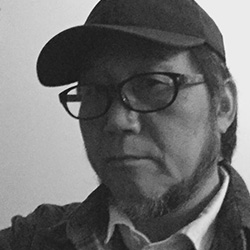Cheng Qi refers to himself as ShidaoRen (Man of Stone’s Profundity), XianyunShanren (Hermit of Leisurely Clouds), as well as Wei (Diligence). In 1956, he was born in She County, Anhui Province, to a family that gave him quality childhood education. He already showed great talent when he started to learn poetry, calligraphy, and painting at the age of seven under his father’s tutelage.
As he grew older, he took to the Xin’anSchool of Painting (a group of Anhui painters in the 17th century excelling at painting local mountains), and would practice painting day and night, with special attention paid to the style of Shi Hongren, Wang Zhirui, and other masters.
His calligraphy was inspired by the masterpieces by Yan Zhenqing (709-784, a great calligrapher best known for his regular script) and the rubbings from stone inscriptions from the Wei and Jin Dynasties. He shows fondness for the inscriptions on ancient bronze ware and stone tablets, especially those from the Qin and Han Dynasties.
He also has predilection for inkstone carving. In the early 1980s, he already led the younger generation of carvers for traditional She County inkstone, and was commissioned by many renowned calligraphers to carve inkstones for them. For the sake of a prestigious Japanese inkstone carver, he once lived at the foot of the Dragon Tail Mountain (a mountain in Jiangxi Province, where the material for famous She County inkstone comes from) for three years to study inkstone carving—an experience that brought him international fame.
Then he shifted the focus of his efforts to the revival of the ancient techniques (believed to have been lost for 300 years) of carving a type of stone called “Green of Yi County” from Anhui Province, an ornamental art form much appreciated by ancient literati. He traveled across Anhui Province to study the “Green of Yi County” left by ancestors of different dynasties. With relentless efforts and deep fascination, he developed his own theory and style of stone carving, combining the nature of “Green of Yi County,” the ancient techniques of stone carving, and the inspirations gained from both nature and the mountains and rocks in the paintings from the Song and Yuan Dynasties—an unprecedented achievement for “Green of Yi County.”
In recent years, he has extended his material from “Green of Yi County” to stone from Yingde City in Guangdong Province, the Tai Lake, Mount Kun in Jiangsu Province, Mount Lao in Shandong Province, and LingbiCounty in Anhui Province (a type he loves the most). Whenever inspiration strikes, strokes of his hatchet and chisel will lead to a wonderful universe in miniature.
In addition, he appropriates the stone masterpieces he has collected, created, and seen for scroll painting. Such appropriations are amenable to various ways of appreciation, giving a vicarious pleasure of being a hermit absorbed in natural scenery. This is credited to his great brushwork and profound understanding of the texture and nature of stone. Connoisseurs lavish attention upon his works due to his exceptional style rarely seen in other stone-painting artists.
Many of his works have found their way into the collection of museums, art institutions, artists, and connoisseursat home and abroad. For them, it is no exaggeration to say that a mere piece of Cheng Qi’s creation is something to “put on pedestal.”





